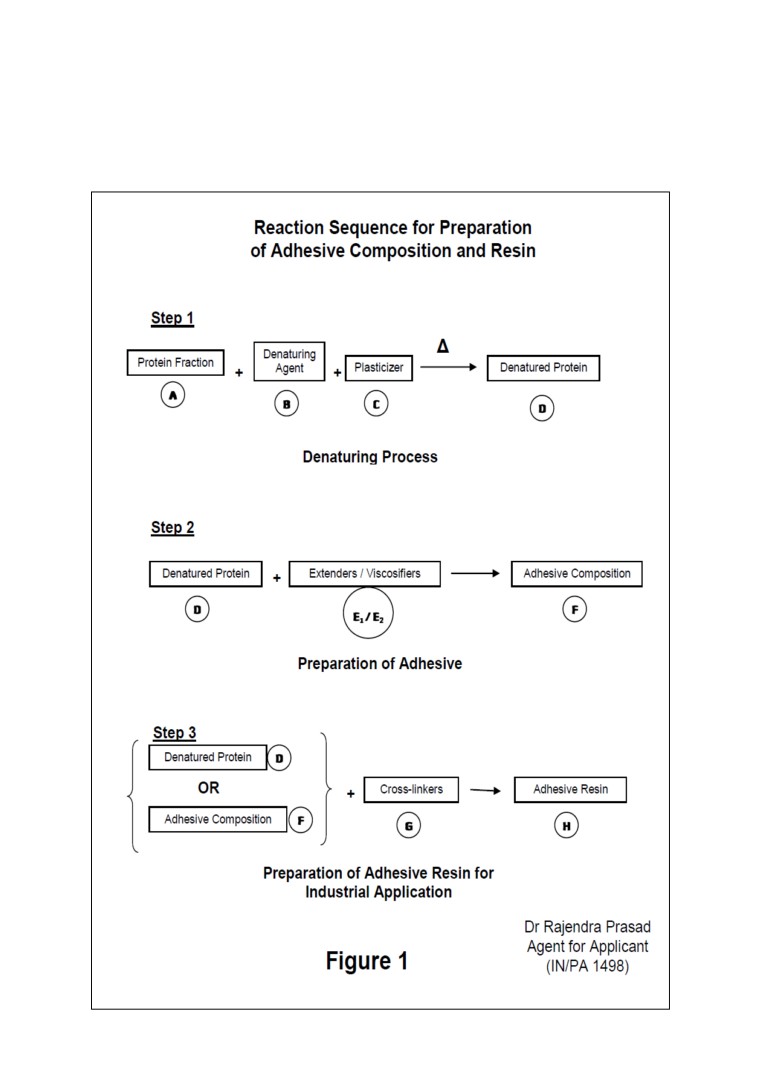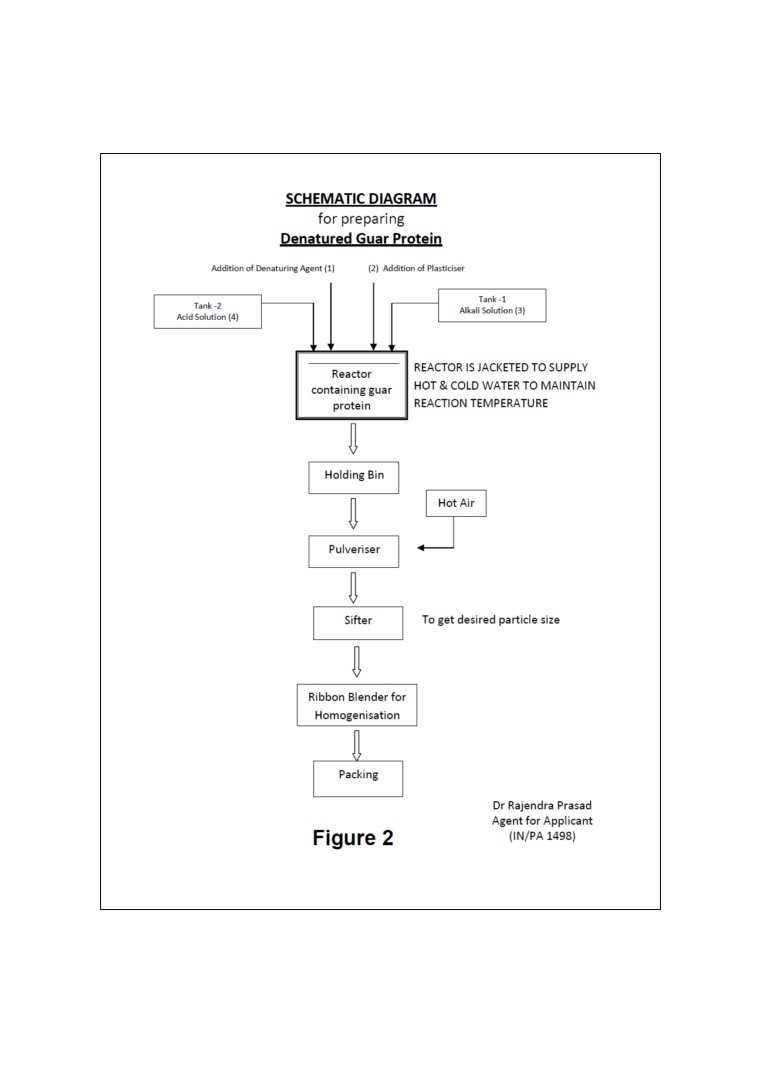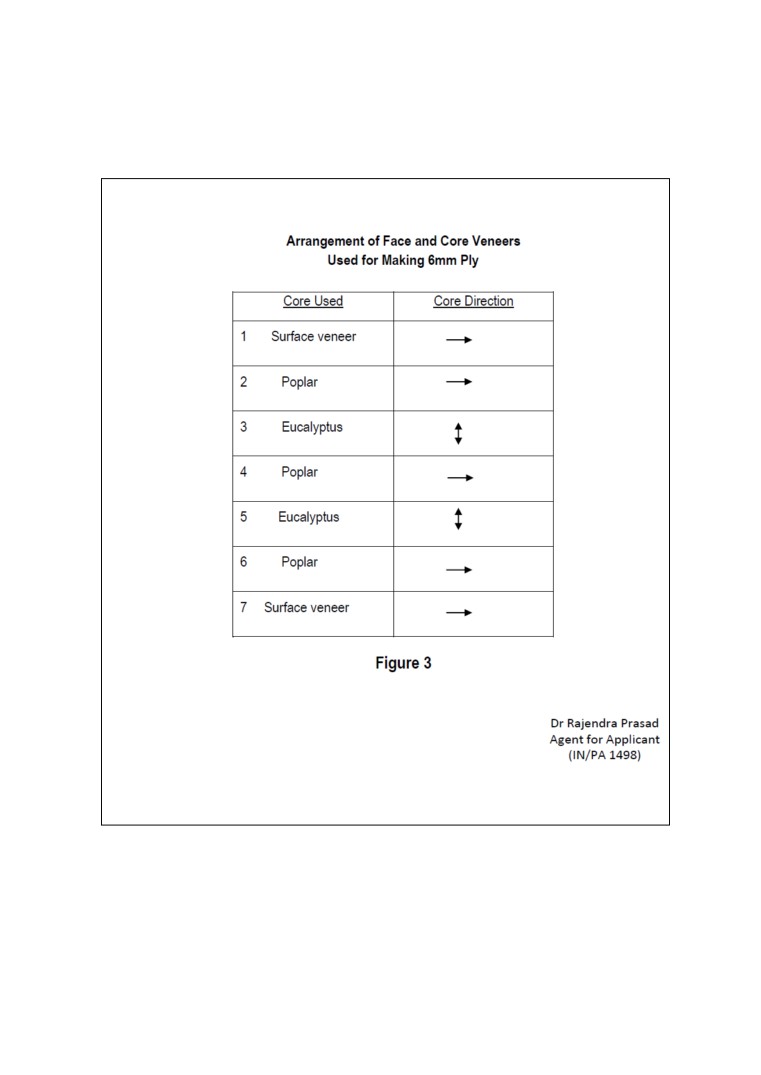FORM 2
THE PATENTS ACT, 1970
(39 of 1970)
&
The Patents [Amendments] Rules, 2006
COMPLTE SPECIFICATION
(See section 10 and rule 13)
GRANTED PATENT No. 274671
AGRO BASED ADHESIVE FOR PLY-WOOD AND
OTHER WOOD COMPOSITES
Hindustan Gum & Chemicals Limited
Birla Colony,
Bhiwani - 127021
Haryana, India
Incorporated under the Companies Act, 1956 (Act No. 1 of 1956)
with registration no 25301 dated 15/2/1962
The following specification particularly describes the invention and the manner in which it performs:
2
AGRO BASED ADHESIVE FOR PLY-WOOD
AND OTHER WOOD COMPOSITES
1.
Technical Field of Invention
The invention relates to the field of agro protein based adhesives and their compositions that find
use in the preparation of ply-wood and other wood composites in partial or whole replacement of
synthetic resins.
2.
Background and the Prior Art
Urea-formaldehyde (UF) based thermoplastic resins have long been used in the production of
different types of ply-wood and other laminated wood composites for interior and exterior
applications. For ease of customization and low cost, UF resins have been preferred choice by
the ply-wood industry that offers much required excellent binding and water resistant properties
to the final products.
Despite high acceptability of UF resins by manufacturers of wood products, there is considerable
concern of its use in domestic and commercial environments for reasons of public health. This
concern is on account of the fact that wood products using UF resins tend to emit small amounts
of toxic formaldehyde gas over a long period of time. Since prolonged exposure to these toxic
emissions is injurious to public health, the use of such wood based products, especially in interior
environments is a subject to regulatory compliance in many countries.
The above concern of formaldehyde emission found expression in US4282119 that describes an
invention for preparation of wood composites using minimal quantity of the formaldehyde resins
in the adhesive formulation.
Rising cost of UF resins is yet another reason for search of alternative adhesives for application
in wood industry that are affordable and environmentally benign with low or no toxic emissions,
especially for indoor environments. The quest for environment-friendly products in this industry
3
led many researchers to look for raw materials from renewable resources while keeping
performance and price at favourable levels. A number of protein rich compounds from natural
resources such as, casein, animal blood and soy proteins are reported to have been developed
and used in place of UF resins to make high performance wood adhesives.
US3153597 describes the application of caseins for wood adhesives. Self curing glue by
reacting a polymeric dialdehyde such as commercially available per-iodate - oxidized dialdehyde
starch or dialdehyde cellulose with casein has been developed. It is claimed that the plywood and
other wood composites prepared by this type of adhesive have higher shear strength and
weather resistant properties. The drawbacks in this process are i) uncontrollable viscosity of the
adhesive since treatment of casein with dialdehyde considerably increases the viscosity and
makes the application of adhesive in wood products difficult, ii) the wood products get stained
with rich tannic acid.
US20100018436 disclosed the use of animal blood for making adhesive for plywood and
laminated wood products. Fresh blood has been used without dewatering it and different
modifiers such as anticoagulant, preservatives added with lime to adjust the pH of the adhesive
in between 9-11. A curing agent has been used to cure the adhesive during processing condition.
Blood protein based adhesives are reported to have higher moisture resistance, but poor shear
strength than the casein based adhesives.
A number of previous US patents, viz., US1976436, US 2400541, US2874134 cited in the above
patent described various methods of making adhesive suitable for plywood, all of which require
the blood to be dewatered and dried before processing making the process unviable. In
US4180412, the blood is pretreated with an anti-coagulant. US4333767 describes method of
making blood-based glue from sprayable blood that had been previously dried.
4
Thus, several animal blood based adhesives are reported in patent literature but none of them is
known to be in commercial use, presumably because all known processes required blood to be
dried before use as a raw material for preparation of adhesive. US20100018436 is a relatively
recent one and does not require dehydration and thus seems to have potential in reviving the
interest in blood-based adhesives.
Among the proteins, obtainable from agriculture sources for making adhesives for plywood or
other wood composites, soybean protein has received much attention. Soy protein was used as
an adhesive for plywood in the early
1900s
(US1813387 and US1724695) even before
petroleum-based UF resins became popular due to their easy availability, and excellent
performance. Environmental considerations due to formaldehyde emission over long periods are
once again turning the attention of researchers back to soy and other agro-based proteins.
US20020005251 describes improved adhesive binder prepared from soy protein by reacting with
different modifiers for application in the wood products essentially to replace commonly used UF
resins. It is stated that due to its bio origin and from an abundant renewable source, the soy
protein based adhesive is environment friendly, and hence preferable than petroleum based
adhesives. The preferred modifier in the above patent application is ‘guanidine hydrochloride’ as
per the granted patent US 6497760.
Nonetheless, the soy protein adhesives, except the formulation as given in US6497760, hitherto
available lack required properties of gluing strength and water resistance, these have, by and
large, failed to become popular. There is, therefore, a felt need for developing more potent agro
based protein adhesives that are more potent than those known in the prior art. The known
shortcomings are now addressed by this invention of modified soy protein based adhesive.
US20080021187 describes an improved method for the production of soy based adhesive by
denaturing the protein by the treatment with urea. Heat treatment has been employed in this
5
invention for the denaturing the protein prior to addition of urea. This process has been stated to
result in to the increased stability and strength of the resultant adhesive prepared from denatured
protein.
US7081159 describes a soy protein based adhesive formulation using zinc sulphate
heptahydrate as cross linking agent where soy protein isolate has been used as a source of soy
protein. A number of inorganic and organic compounds have been included in the formulation to
impart better stability and binding strength. However, the soy protein isolate is more expensive
as compared to the common soy protein or soy flour.
Soy flour / protein based adhesive has attracted the attention of many researchers for obvious
reasons for application in wood composites made with such adhesives. Most of these
formulations have thus far offered low shear strength and poor moisture resistance as compared
to formaldehyde based synthetic resins. Nevertheless, a search for high performance adhesive
based on agricultural resource for wood applications continues to be on the wish-list that has the
potential to replace UF resin for such applications.
US4282119 describes the preparation of wood composites made of urea-formaldehyde or urea
melamine formaldehyde resins. The use of formaldehyde resins has been minimized to the
extent possible to control the resultant emission of formaldehyde in the final end products.
US3268460 describes preparation of adhesive for wood industry from phenol aldehyde and uses
small amount of guar or casein as additive.
WO2007017590 describes guar protein extract product and method for the production and uses
thereof which is a PCT application designating more than 100 countries and regional offices of
EAPO, EPO, ARIPO, and OAPI. This invention relates to cosmetic or pharmacological or plant
protective compositions or to domestic care agents based on modified guar protein extract and
methods for the production thereof.
6
We, however, report herewith hitherto unreported agro-based adhesive compositions based on
protein obtainable from sources other than soy and casein, particularly guar and others that are
commonly found in India for ply wood and wood composites industry that can replace expensive
and toxic synthetic ingredients, urea-formaldehyde resins.
3.
OBJECTIVE OF THE INVENTION
The main objective of this invention was to develop a high performance adhesive for application
in wood industry from guar protein, a bye product of guar gum manufacturing that has
comparable or better performance with commonly used UF resins in terms of binding properties
and low moisture susceptibility.
4.
SUMMARY OF THE INVENTION
The guar protein, a bye product of guar gum manufacture has been deployed to produce an
adhesive suitable for wood applications. The guar protein obtained as a bye product from the
process of guar gum manufacture, is denatured through a series of chemical reactions in a
controlled manner.
The denatured guar protein is then cross-linked by addition of a suitable cross-linking agent in its
aqueous solution. The denaturing of guar protein and subsequent cross-linking with suitable
cross-linking agents are central and key steps in developing guar protein based adhesive
composition and resin. The cross-linked guar protein can optionally be mixed with suitable
extenders and viscosifiers to impart different characteristics to adhesive composition that can be
employed for preparation of ply wood and other wood composites in place of commonly used UF
resins.
The guar protein based wood adhesive of the present invention provides a high performance
wood adhesive as an alternative to the synthetic resin based adhesives and can be regarded as
7
‘green technology’. The wood composites manufactured from the guar protein based adhesives
can be used for both interior and exterior applications.
5.
STATEMENT OF INVENTION
A heightened concern on human health and environment due to slow and continuous
formaldehyde emissions from urea-formaldehyde resin based adhesives used in wood products
over long periods of time necessitated to look for environmentally benign alternatives to UF
resins.
A range of agro-based protein rich renewable resources such as casein, animal blood, soybean
protein, etc have attracted the attention of researchers to develop alternative adhesives.
For the first time, we report an invention based on guar protein that is a bye product of guar gum
manufacture, a large scale production and export of which takes place from India and many other
countries around the world. A process of preparation of high performance adhesive based on
guar protein as well as its composition for use in wood applications is disclosed.
6.
BRIEF DESCRIPTION OF THE ACCOMPANYING DRAWING(S)
Having thus described the invention in general terms, reference will now be made to the
accompanying drawings wherein:
FIG. 1 shows a general scheme of reaction sequence for preparation of guar protein based
adhesive composition and resin through three main steps
FIG. 2 shows a schematic diagram for preparing denatured guar protein, an essential step in
making the adhesive composition / resin
FIG.
3 shows the arrangement and the face / core veneers used in making the
6 mm
experimental ply for evaluating the bonding strength of glue composition with denatured guar
protein of this invention
8
7.
DETAILED DESCRIPTION OF THE INVENTION
The present invention provides a high performance adhesive composition produced by chemical
and physical modification of guar protein in the presence of alkali and urea that is used with
suitable cross-linking agents in the final application for adhesion in the plywood industry through
various steps as described in Figures 1 and 2.
The guar protein is a protein rich bye product obtained from the guar seed. Guar seed is
composed of a pair of tough, elastic endosperm sections, referred to as “guar splits” between
which is sandwiched brittle embryo (germ). The germ section is a rich source of guar protein. The
entire structure is confined in a tough seed coat referred to as hull. The seed is broken into two
halves by mechanical attrition (a well known technology of guar seed processing). The protein
rich germ is separated during this process. The purified guar splits prepared through multi-step
process are subjected to milling to obtain guar gum powder of different grades.
The guar seed contains about 28-35 % galactomannan polysaccharide and 45-60 % pretentious
material. The split is reported to contain nearly 80 % galactomannan with minor amount of
pretentious material, inorganic salts, water insoluble fiber etc. The process of producing pure
guar split and the protein rich bye product are well-known and form part of the contemporary guar
gum technology.
The ’guar protein’ obtained as a bye product in guar gum technology is the basic raw material for
the invention disclosed herewith and comprises nearly 45% by weight of protein content. The
protein content in this starting raw material is determined by measuring the nitrogen content by
standard Kjeldahl method for nitrogen estimation. The remaining portion of guar protein
additionally contains small amount of galactomannan polysaccharide, oil, water, sugar unit, fiber
and minerals. The protein part is known to contain wide varieties of amino acids, principally
9
glutamic acid, arginine, aspartic acid, lysine, cystine, tyrosine, histidine, serine, proline and
several others in small amounts.
The isolated guar protein obtainable in dry form (with small amount of moisture content to the
extent of up to 5-7%) as a bye product from the guar gum manufacture is used for conversion to
the adhesive composition directly or after milling it to form a powder.
Step 1: The first crucial step in conversion of ‘guar protein’ to adhesive composition or a resin is
denaturing of the protein as shown in Figure 1. The ‘guar protein’ (A) is denatured using a
suitable ‘denaturing agent’ (B) in presence of a suitable plasticizer (C), where:
B = urea, guanidine hydrochloride, heat, acid, alkali, alcohol, sound waves of appropriate
frequency or a combination of any of these agents, and
C = plasticizer of the type of polyhydric alcohol, e.g., 1,6-hexane diol; 1,4-butane diol; 1,3-
propane diol; 1,2-ethane diol; 1,2,3-propane triol (glycerol) etc.
At the end of denaturing step, the pH of the reaction mass is lowered to about 7 by adding
inorganic or organic acid. The inorganic acid may my hydrochloric acid, sulphuric acid or nitric
acid of appropriate concentration. The organic acid may be acetic acid, phosphoric acid, fumeric
acid, citric acid or any other organic acid.
The guar protein when denatured unfolds from its native coiled structure thereby exposing the
functional groups like -COOH, -OH,-SH, -NH2 of the protein backbone available for cross-linking
in the subsequent steps. It is an important step in the process and needs to be carried out with
extreme care to avoid excessive denaturing since that can result into significantly reduced pot
stability and adhesive strength of the final product.
The property of plant based proteins to exhibit unfolded structures when denatured is well known.
This has been gainfully exploited in the prior art with regard to proteins obtained from soy, e.g., in
10
US 6497760. We have used this insight with regard to protein obtained from guar in this
invention. The unfolded protein structure helps enhance the contact area of functional sites
thereby increasing the much needed adhesion and bonding strength. An excellent insight into the
effect of different denaturants, viz., sodium dodecyl sulphate
(SDS), urea and guanidine
hydrochloride on guar protein fractions has been provided through observations on sedimentation
velocities, viscosities, ultra-violet and florescence spectra by Nath JP et al.1. The optimum
denaturing in this invention, however, is achieved by standardization through trial of various
batches with different denaturants under varying conditions.
While the reaction sequence of conversion of the guar protein to the adhesive composition and
resin through the crucial denaturing step is shown in Figure 1, the manufacturing scheme for the
denatured protein in a batch reactor following the unit operations of neutralization, cooling,
drying, sifting and homogenizing etc. are shown in Figure 2.
Example:
An example of working the Step 1 is given below to demonstrate the performance of the invention
without limiting its overall scope as already described above.
About 100 kg of guar protein is first charged into the reactor and mixed with small amount of a
suitable plasticizer thoroughly. A suitable denaturant or a mixture of denaturants, such as caustic
soda and urea etc. in about 10-15% of the mass of guar protein in an aqueous solution is then
slowly added. The mixture is then heated to between 30-950C over a period between 1-9 hours.
The reaction mass is then cooled to room temperature following which it is neutralized with 50%
sulphuric acid solution. A final reaction product containing denatured guar protein in semi-solid
state in about 110 kg is then obtained.
1 Nath* JP and Rao M.S Narasingha, Effect of denaturants on the 11S protein of guar seed ( Cyamopsis
tetragonoloba), J. Biosci., Vol. 5, Number 3, September 1983, pp. 209-217.
11
The reaction mass is then dried, pulverized and stored in cool and dry place for further use.
The characteristics of denatured guar protein produced by the above method are shown below in Table 1:
Table 1
S.No.
Parameter
Value
1
Viscosity 20% w/v at 25 0C measured
2000 cps
by Brookfield viscometer
(approx)
2
Moisture content (%)
5
3
pH (20% w/v solution)
ca.7
4
Particle Size (passes thro’ 100 mesh)
90%
It may be noted that alkali, urea and heat together act as denaturing agents in this example. In
practice, however a variety of combination of denaturing agents could be employed to get the
right and optimum conformation of the denatured protein structure adjudged so by visual
appearance as well as the performance of the converted product.
Step 2: The next step in the process involves blending of (denatured) guar protein (D) with
suitable extenders (E1) and viscosifiers (E2) to make adhesive composition (F) as shown in the
Step 2 of Figure 1, where
E1 = any food grade or industrial grade maidaα, ground nut cake powder, coconut shell powder,
etc. The extender is used to provide required thickness and flow to the aqueous solution of
the adhesive composition, and
E2 = guar gum, pre-gelatinized and gelatinized starch, cassia gum, tamarind kernel powder etc.
α Maida is a finely-milled wheat flour of less than 200 mesh per sq inch commonly used for making variety of breads
in India and other Asian countries.
12
Suitable quantities of the extenders (E1) / viscosifiers (E2) may be added to the denatured guar
protein (D) in accordance with the desired requirement of the thickness and flow of the solution of
resultant composition (F). Thus, different grades of guar adhesive composition (F) can be
prepared for various end applications keeping in mind the processability and binding
performance.
The extender is used to provide required thickness and flow to the aqueous solution of the
adhesive composition, and the viscosifier is added to increase the viscosity of the solution and to
provide a smooth spreading of the aqueous solution of the adhesive composition on the surface
of the ply. Appropriate commercially available preservatives could be added to the adhesive
composition powder or its aqueous solution to avoid microbiological growth during storage.
The adhesive compositions of the present invention have been developed for specific application
for ply-wood, laminate board and other wood composites essentially as replacement of
environmentally sinister urea-formaldehyde resin.
Step 3: The last and the third step in the process is basically a pre-processing step in the end
application. The denatured guar protein (D) or adhesive composition (F) as shown in the Step 3
of Figure 1 are allowed to react with suitable cross-linking agents (G) to produce adhesive resin
(H) which directly finds application in ply-wood industry or similar applications. In the step 3:
G = formaldehyde containing cross-linking agent such as formaldehyde, urea formaldehyde,
phenol-formaldehyde, resorcinol and melamine or a combination thereof
or
formaldehyde free cross-linking agent of isocyanates such as polymeric methyl diphenyl
diisocyanate
(pMDI), amine-epichlorohydrin resins such as polyamidoamine-
epichlorohydrine (PAE), epoxy, aldehyde, zinc sulphate hepta hydrate and / or urea based
resins
13
A variety of cross-linking agents can be employed in this step. However, formaldehyde free
cross linking agent within a favourable cost - performance envelope is desirable to meet the
objectives of minimizing toxic emissions of formaldehyde in this invention.
Binding Performance of Denatured Guar Protein Based Adhesive Composition / Resin
The Step 3 is an important step before the denatured guar protein (D), the main product of this
invention and / or its marketable adhesive compositions (F) for variety of end applications to
impart necessary adhesion. Experiments below are described to demonstrate the use of this
invention and its superior performance as compared to the industrial resins of the prior art
available commercially. These also demonstrate the environmental-friendly characteristics of the
products of this invention.
An aqueous solution of the powder (as obtained in Step 1 or in Step 2) is reacted with a suitable
cross-linking agent to make the adhesive resin. The choice for type and amount of cross-linking
agent used for making the resin in this invention depends on several factors such as the pot life,
cross linking rate, cost of the adhesive product, as well as on the nature and characteristics of the
denatured guar protein making available cross-linking sites. The cross-linkers used in the
experiments below are with a view to demonstrate the use of this invention and do not limit the
scope of its use with other possible cross-linkers imparting desired cost-performance advantage.
Experiment 1
An aqueous solution of the 10 kg of denatured guar protein is mixed with 60 kg of water and 10
kg formaldehyde (35% solution) to form a homogenous slurry that is directly used in making a
standard 12 mm thickness of commercial grade ply-wood experimental sample of 8’x4’. The glue
for control sample was made with 80 kg of UF resin along with 8 kg maida and 2 kg GNPC
(ground nut coconut powder). The following experimental conditions were maintained:
14
Glue spread = 26-27gm per sq ft.
Pressure = 130 kg per sq cm
Curing temperature = 125-130OC
Curing time = 9, 12, 15 and 18 min for experimental samples and 15 min for the control sample
The value of glue shear strengths
(GSS) determined as per IS:1734
(Part
4)
-
1983
{Determination of Glue Shear Strength (Second Revision) } were observed and given in Table 2
below:
Table 2
Glue Shear Strength Experiment taking UF Resin as Control
Glue Shear Strength
@ kg per sq cm
Sample
Curing Time
Value
No.
1
9 min
1050
2
12 min
1200
3
15min
1450
4
18 min
1250
Shear strength of the Control Sample with
commercial UF resin with identical conditions and
the curing time of 15 min was determined as
1000 kg per sq cm.
It is evident from the results of Experiment 1 that the performance of the product of this invention is better
than the commercially used UF resin of the prior art under similar working condition. However, necessary
optimization with regard to curing time with new formulation is required; at lower curing time, the shear
strength is below the optimum whereas at higher curing time, the shear strength drops below the optimum.
The use of formalin, however, is not preferable and alternative cross-linking agents are being developed.
15
Experiment 2
An aqueous solution of the 200 g of denatured guar protein in 400 g water is mixed with 600 g kymeneα
557H and is directly used in making a standard
12 mm thickness commercial grade ply-wood
experimental sample of 1’ x 1’ with experimental conditions used as in Experiment 1.
While the glue shear strength (kg per sq cm) of the control sample was 1000, the same for the test sample
was 1580, far exceeding that of the control sample using UF resin of the prior art.
This clearly demonstrates that the resin obtainable from this invention shows higher binding performance
as compared to the commercially available UF resins.
Experiment 3
In this experiment, while the glue for control sample constituted 90 kg UF resin along with 9 kg maida and
1 kg GNCP, the same for the experimental resin was prepared by using 10 kg of denatured guar protein
with 45 kg of water and 45 kg of UF resin. These were used in making a standard 18 mm thickness of
commercial grade ply-wood experimental sample of 8’x4’. The experimental conditions maintained here
were as follow:
a) Glue spread = 26-27 gm per sq ft
b) Pressure = 130 kg per sq cm.
c) Curing temperature = 125-130OC
d) Curing time = 23 min
The value of glue shear strengths
(GSS) determined as per IS:1734
(Part
4)
-
1983
{Determination of Glue Shear Strength (Second Revision) } were observed and given in Table 3
below:
…………………………..
α Kymene 557H is commercially available amine-epichlorohydrin type of resin from Hercules Inc. used in this
experiment as a cross-linking agent
16
Table 3
Glue Shear Strength Experiment taking UF Resin as Control
Glue Shear Strength
@ kg per sq cm
SNo
Resin
Value
1
UF resin (control)
1100
2
Experimental resin
1600
It is evident from the results shown above that the binding performance of the adhesive
composition of this invention is significantly better than the commercial product of the prior art
offering the same or more strength of the plywood. The product of this invention is capable of
avoiding the environmentally sinister UF resin altogether or can work with a significantly reduced
amount.
Examples and Mode of Enablement
To validate industrial applicability of the disclosed invention, a number of experiments towards
optimization of operating conditions were carried out. As already described, a number of variants
in different modes play their part at each step which has been tried with the basic understanding
of the role of each constituent to work out the ‘best mode’ of working of this invention. Following
experimental details sum of the ‘best mode of enablement’ as discovered.
Denaturing Process
Denaturing process of guar protein with different agents has considerable impact on the adhesion
property and bonding strength of the glue composition prepared with the denatured guar protein.
The best mode of evaluating the suitability of a denaturant and the reaction conditions can,
therefore, be set up through experimental plywood making process with glue compositions made
17
with different denatured protein preparations as simulated to industrial scale processes. The
quality of experimental plywood pieces thus prepared can be measured in terms of i) Water
resistance and ii) Glue Shear Strength as per Indian standards IS:1734 (Part-6) and IS:1734
(Part-4)-1983 respectively.
Making of Plywood Samples and Testing
Standard plywood making procedure was employed using the experimental and reference glue
compositions for making a 6mm ply with arrangement of face veneers and core veneers as
shown in Figure 3. While the face veneers are on the outer surface, the core veneers comprising
of poplar and eucalyptus (known commonly as ‘safeda’ in India) alternatively with their strands
transverse to each other as shown in Figure 3.
A pre-determined amount of glue was spread between each surface and the operating conditions
used for all the samples and reference standard ply were identical and conformed to the following
parameters:
a) Glue Spread = 26-27 gm per sq. ft
b) Pressure of the Hot Press = 130 kg per sq. cm
c) Curing Temperature = 125-1300C
d) Curing Time = 8 minutes
The Indian Standard IS:1734 (Part-6) for determination of water resistance is basically an
immersion test, according to which the specimen is kept immersed in warm water at
70±20C
for a period of 3 hours. The test pieces are then removed from warm water and cooled down to
18
ambient temperature by plunging into water kept at the room temperature. Visual examination
for de-lamination, blister formation etc. is then made for each ply.
The Indian standard IS:1734 (Part-4) in its second revision published in 1983 describes the
method by which glue shear strength (GSS) of the bonding of plywood is determined, according
to which the values of samples along with the reference standard ply were measured and
recorded.
Test Samples of Denatured Guar Protein
In a typical batch for denaturing of guar protein, 100 kg raw guar protein is charged into a
reactor and mixed with a small amount of plasticizer say, glycerol. A suitable denaturant or, a
mixture of denaturants (as described below), in about 10-15 % of the mass of guar protein in an
aqueous medium is slowly added during the course of reaction. The mixture is continuously
heated at 30-950C over a period 1-9 hours. The reaction mass is then cooled to room
temperature and neutralized with ~50% sulphuric acid solution or other inorganic / organic acids.
About 110 kg of the denatured guar protein in a semi-solid state is thus obtained which is then
dried and stored in cool and dry place for further use.
Eight test samples of denatured guar proteins with the above method were prepared for
experimental plywood making process and testing the bonding strength of the resulting glue
compositions. These are given below in Table 4:
19
Table 4
Denatured Guar
Denaturant & the Manner in which Used
Protein Samples
DGP(C)
Denaturant used is 10 - 15 % caustic solution at the initial stages of the
reaction
DGP(U1)
Denaturant is a combination of 10 - 15 % caustic solution at the initial
stages followed by addition of urea when the reaction has proceeded half
way
DGP(U2)
Denaturant is a combination of 10 - 15 % caustic solution at the initial
stages followed by addition of urea at the end of the reaction time
Denaturant used is a combination of 10 - 15 % caustic solution followed
DGP(S)
by urea in about 5-10% of the mass of guar protein when the reaction has
proceeded half way followed by pH adjustment of the reaction mass at
the end of the reaction with 50% solution of sulphuric acid
Denaturant used is a combination of 10 - 15 % caustic solution followed
DGP(A)
by urea in about 5-10% of the mass of guar protein when the reaction has
proceeded half way followed by pH adjustment of the reaction mass at
the end of the reaction with 50% solution of acetic acid
Denaturant used is a combination of 10 - 15 % caustic solution followed
DGP(Ct)
by urea in about 5-10% of the mass of guar protein when the reaction has
proceeded half way followed by pH adjustment of the reaction mass at
the end of the reaction with 50% solution of citric acid
Denaturant used is a combination of 10 - 15 % caustic solution followed
by urea in about 5-10% of the mass of guar protein when the reaction has
DGP(SB)
proceeded half way followed by partial pH adjustment of the reaction
mass at the end of the reaction with 50% solution of sulphuric acid so that
the reaction mass remains alkaline (pH 9.00 - 11.00)
Denaturant used is a combination of 10 - 15 % caustic solution followed
by urea in about 5-10% of the mass of guar protein when the reaction has
DGP(SA)
proceeded half way followed by traetment of the reaction mass at the end
of the reaction with 50% solution of sulphuric acid so that reaction mass
turns distinctly acidic (pH 5.00 - 7.00)
20
Further to preparation of denatured guar protein samples as described above, eight experimental
glue compositions were prepared corresponding to each denatured guar protein samples
described above by taking 11 kg of the substance in about 39 kg of water to which about 50 kg of
UF resin was added. The performance of these glue compositions were tested against standard
glue made of 90 kg of UF resin with 9 kg of maida and 1 kg of GNCP as per the norms prevailing
in Indian plywood manufacturing industry. This comparative formulation was also chosen to offer
at least 40 kg of reduction of UF resin in an equivalent batch as per one of the objects of our
invention. Using these glue compositions, plywood samples were prepared and tested as
described above to evaluate the quality of denatured guar protein samples.
The results of testing of the experimental ply made with glue compositions of this invention as
compared to that made with standard glue are presented in Table 5 below:
Table 5
Observation on
Determined
Glue Compositions
‘Water Resistance’
GSS Value
Used for making Ply
of Ply
of Ply
1. Standard Glue
Moderate
1100 kg per sq. cm
2. DGP(C)
Moderate
950 kg per sq. cm
3. DGP(U1)
Excellent
1450 kg per sq. cm
4. DGP(U2)
Good
1250 kg per sq. cm
5. DGP(S)
Excellent
1400 kg per sq. cm
6. DGP(A)
Excellent
1450 kg per sq. cm
7. DGP(Ct)*
Excellent
1300 kg per sq. cm
8. DGP(SB)
Poor
700 kg per sq. cm
9. DGP(SA)
Poor
550 kg per sq. cm
* Ply made from the glue using Citric acid [DGP (Ct)] as neutralizer has a tendency to stickiness to the
plates at Hot Press during curing.
21
Effect of Varying Curing Times
Since different glue compositions require different curing times to give optimum results in ply
making, a comparative analysis of the effect of varying curing times using one of the glue
compositions from this invention, DGP(S) against the standard glue composition was also carried
out. Table 6 below gives the results of this experiment:
Table 6
Observations
Curing
Ply (6mm) made from standard glue
Ply (6mm) made from denatured guar
Time
protein glue, DGP(S)
5 min
Appearance ok but quality not at par
Premature ply, quality not ok
6 min
Appearance ok, quality also at par
Premature ply, quality not ok
7 min
Appearance ok and quality also at par
Appearance ok but, quality not at par
8 min
Appearance ok and quality also at par
Appearance ok and quality also at par
9 min
Overheated ply, quality not ok
Appearance ok and quality also at par
10 min
-
Overheated ply, quality not ok
Since it is customary to make ply of different thicknesses in industry, attempts were also made for
making ply of thicknesses beyond 6mm, viz., 9mm, 12mm, 15mm and 18 mm with glue
composition, DGP(S) of this invention and optimum curing times were observed as given in the
Table 7 below. It was observed that it was possible with suitable adjustments of curing times, i.e.,
in excess of about 2 min than with the conventional glue composition, excellent quality of
plywood can be made with the glue compositions of this invention.
22
Table 7
Optimum Curing Times for Different Thickness Ply
Made from Glue Composition, DGP(S)
Ply Thickness
Curing Time
Observation
6 mm
8 min
Appearance ok, quality of ply at par
9 mm
12 min
Appearance ok, quality of ply at par
12 mm
15 min
Appearance ok, quality of ply at par
18 mm
22 min
Appearance ok, quality of ply at par
23
We claim:
1.
A method for making an agro based high performance adhesive, particularly from protein
fraction of guar (Cyamopsis tetragonolobus) which is denatured by heating in presence of a
plasticizer and a modifier followed by neutralization and working up the reaction mass through
three important steps as disclosed in this invention.
2.
The method of claim 1, wherein the guar protein product is denatured by application of heat
and / or reacting with an alkaline material which could be urea, guanidine, sodium hydroxide,
sodium carbonate, potassium hydroxide etc. or any other similar agent.
3.
The method of claim 1, wherein the plasticizer is used in the denaturing process of Step 1,
which may be glycerol, 1,6 hexane diol, 2,5 hexane diol, 1,4 butane diol, 2,3 butane diol etc..
4.
The method of claim 1, wherein the pH adjustment of the final reaction mass is done with an
acidic solution of sulphuric acid, acetic acid, citric acid or any other inorganic / organic acid.
5.
Denatured guar protein prepared with the method of claim 1 and that is in the powder form with
less than 10% moisture content and particle size 90% of which passes through 100 mesh and
whose aqueous solution (20% w/v) has a pH between 6 and 9.
6.
The product of the method of claim1 finding commercial applications e.g., in plywood industry is
blended with extenders such as food / industrial grade maida, ground-nut cake powder,
coconut shell powder etc. that exhibits a viscosity of 2000 - 8000 cps at 25OC.
7.
The use of denatured guar protein of claim 5 and 6 in powder or aqueous form for application
as high performance adhesive in plywood industry and other similar industrial sectors where
cross linking agent may be urea formaldehyde resin or melamine formaldehyde resin.
Dated
24thd day of June 2011
Dr Rajendra Prasad
Agent for Applicant (IN/PA 1498)
24
ABSTRACT
AGRO BASED ADHESIVE FOR PLY-WOOD AND
OTHER WOOD COMPOSITES
An agro based high performance adhesive and compositions made thereof that find use in the preparation
of ply-wood and other wood composites have been develop from protein fractions obtained as bye
products of various agro industries, i.e., protein of galactomannan.
These compositions have comparable or better performance as compared to commonly used urea-
formaldehyde (UF) resins which pose severe environmental challenges and health effects, especially in
the indoor applications and therefore have the potential of replacing their use.
The process of preparation of adhesive and their compositions involves denaturing of protein through a
series of chemical and physical transformations and subsequently reacting with appropriate cross-linking
agents. The process(es) require extreme care in controlling the conditions to obtain the right
conformations of denatured protein molecules with appropriate physical characteristics and in employing
the type and amount of cross-linking agent for optimum performance of the end product(s).
25
Applicant’s Name: Hindustan Guar Gum & Chemicals, Bhiwani
No. of Sheets: 03
Application No.1602/DEL/2010
Sheet No. 01 of 03
26
Applicant’s Name: Hindustan Guar Gum & Chemicals, Bhiwani
No. of Sheets: 03
Application No.1602/DEL/2010
Sheet No. 02 of 03
27
Applicant’s Name: Hindustan Guar Gum & Chemicals, Bhiwani
No. of Sheets: 03
Application No.1602/DEL/2010
Sheet No. 03 of 03


























